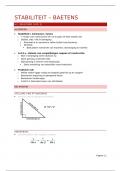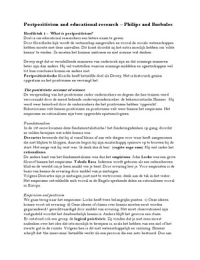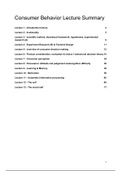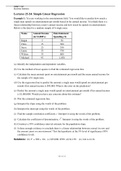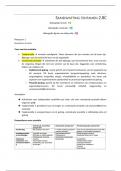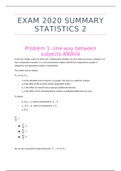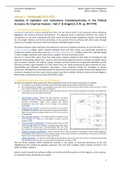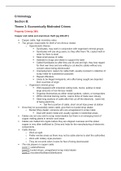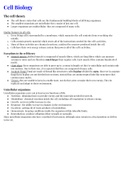Toegepaste microbiologie
Inhoud
1 Genen .................................................................................................................................................... 4
1.1 De flow van genetische informatie ............................................................................................... 4
1.2 De structuur van nucleinezuren .................................................................................................... 4
1.2.1 Structuur van DNA ................................................................................................................. 4
1.2.2 Structuur van RNA ................................................................................................................. 5
1.3 Eukaryoot DNA .............................................................................................................................. 6
1.4 DNA replicatie................................................................................................................................ 6
1.4.1 Rollling circle replication ....................................................................................................... 6
1.4.2 Eukaryoten DNA replication .................................................................................................. 6
1.4.3 Replication machinery ........................................................................................................... 6
1.5 Genen ............................................................................................................................................ 7
1.5.1 Genen die coderen voor eiweitten........................................................................................ 8
1.5.2 Genen die coderen voor tRNA en rRNA ................................................................................ 8
1.6 Transcriptie .................................................................................................................................... 9
1.7 Translatie ....................................................................................................................................... 9
2 Regulatie van genexpressie ................................................................................................................. 10
2.1.1 Regulatorische eiwitten....................................................................................................... 10
2.1.2 Het lac operon ..................................................................................................................... 12
2.1.3 Lac operon: Negatieve controle van induceerbare genen .................................................. 13
2.1.4 Het tryptofaan operon:negatieve controle van represseerbare genen .............................. 13
2.1.5 Het arabinose operon: controle door een eiwit met dubbele werking .............................. 13
2.1.6 Twee componenten systemen en fosforelay systemen ...................................................... 13
2.2 Regulatie van transcriptie elongatie............................................................................................ 14
2.2.1 Attenuatie............................................................................................................................ 14
2.2.2 Riboswitches ........................................................................................................................ 16
2.3 Regulatie op translatie niveau ..................................................................................................... 16
2.3.1 Regulatie van translatie door riboswitches ......................................................................... 16
2.3.2 Regulatie van translatie door small RNA ............................................................................. 16
2.4 Globale regulatorische systemen ................................................................................................ 16
, 2.4.1 Katabolische repressie......................................................................................................... 17
2.4.2 Catabolisch activator protein (CAP) .................................................................................... 17
3 Genetische variatie .............................................................................................................................. 17
3.1 Mutaties ...................................................................................................................................... 17
3.1.1 Spontante mutaties ............................................................................................................. 17
3.1.2 Geinduceerde mutaties ....................................................................................................... 18
3.1.3 Effecten van mutaties.......................................................................................................... 18
3.1.4 Mutaties in genen die coderen voor eiwitten ..................................................................... 19
3.1.5 Effect van mutaties .............................................................................................................. 20
3.1.6 Mutaties in regulatorische sequenties ................................................................................ 20
3.2 Detectie en isolatie van mutanten .............................................................................................. 20
3.2.1 Detectie van mutanten........................................................................................................ 20
3.2.2 Carcinogeneciteitstesten ..................................................................................................... 20
3.3 DNA herstel ................................................................................................................................. 21
3.3.1 Excision repair ..................................................................................................................... 21
3.3.2 Direct repair......................................................................................................................... 22
3.3.3 Mismatch repair .................................................................................................................. 22
3.3.4 Recombination repair .......................................................................................................... 22
3.3.5 SOS response ....................................................................................................................... 22
3.4 Genetische variatie ...................................................................................................................... 23
3.4.1 Recombinatie in eukaryoten ............................................................................................... 23
3.4.2 Horizontale genentransfer in prokaryoten.......................................................................... 23
3.4.3 Bacteriaal plasmide ............................................................................................................. 25
3.4.4 Conjugatie............................................................................................................................ 25
3.4.5 Transformatie ...................................................................................................................... 26
3.4.6 Transductie .......................................................................................................................... 27
3.5 Mapping het genoom .................................................................................................................. 28
3.5.1 Hfr mapping ......................................................................................................................... 29
3.5.2 Transformatie mapping ....................................................................................................... 29
4 Recombinant DNA technologie ........................................................................................................... 29
4.1 Restricite enzymes....................................................................................................................... 30
4.2 Gelelectroforese .......................................................................................................................... 30
4.3 Southern blotting ........................................................................................................................ 30
,4.4 DNA fingerprinting ...................................................................................................................... 31
4.5 Moleculaire hybridisatie .............................................................................................................. 31
4.6 cDNA ............................................................................................................................................ 31
4.7 PCR............................................................................................................................................... 32
4.8 kloneneren .................................................................................................................................. 34
4.8.1 Kloneringsvectoren.............................................................................................................. 34
4.8.2 Plasmiden als kloneringsvector ........................................................................................... 34
4.8.3 Fagen als vectoren ............................................................................................................... 36
4.8.4 Cosmiden als vectoren ........................................................................................................ 36
4.8.5 Artificiele chromosomen als vectoren ................................................................................ 36
4.9 Expressievectoren ....................................................................................................................... 37
4.9.2 Eukaryote expressiesystemen ............................................................................................. 38
4.10 Genenbanken of genenbibliotheken ........................................................................................... 39
4.10.1 Fenotypische rescue ............................................................................................................ 39
4.10.2 Probe vs primer ................................................................................................................... 39
4.10.3 Probe werking...................................................................................................................... 40
4.11 Genetic engineering .................................................................................................................... 40
4.11.1 Knock outs ........................................................................................................................... 40
4.11.2 Raportergenen GFP ............................................................................................................. 41
4.11.3 Gentherapie......................................................................................................................... 41
4.11.4 RNA interferentie (‘gene silencing’) .................................................................................... 41
4.11.5 Crispr CAS 9 ......................................................................................................................... 42
, 1 Genen
DNA = molecule dat de genetische informatie van een organisme bevat.
RNA = zorgt ervoor dat deze genetische informatie tot expressie komt zodat enzymen en andere eiwitten
aangemaakt kunnen worden.
1.1 De flow van genetische informatie
van DNA, over RNA tot eiwit ➔ het centrale dogma
De flow van de ene generatie op de andere (replicatie);
De flow binnen een cel (genexpressie)
DNA fungeert als opslagmolecule van alle genetische informatie die gedupliceerd
wordt en doorgegeven aan het nageslacht.
Synthese van DNA kopie ➔ replicatie. Wordt gekatalyseerd door DNA
polymerase.
Genexpressie begint met de aanmaak van van een RNA kopie van het gen. ➔
transcriptie
DNA-base sequentie wordt overschreven in een RNA-base sequentie, uitgevoerd
door RNA-polymerase.
Tijdens de laatste fase van genexpressie, de translatie. Wordt de basensequentie van het mRNA vertaald
naar een aminozuursequentie van een polypetide-keten.
1.2 De structuur van nucleinezuren
DNA en RNA zijn polymeren van nucleotiden, hangen aan elkaar via fosfo diester verbindingen.
DNA ➔ G, C, T, A suiker = deoxyribose
RNA ➔ G, C, U, A suiker = ribose
1.2.1 Structuur van DNA
2 polynucleotide-strengen die opgerold zijn zodat ze een dubbele helix vormen. Bevat purines en
pyrimidines (allebeie vastgehecht aan het 1’-C uiteinde van de suikers) die samengehouden worden via
fosofdiester bindingen.
Een fosforzuur vormt een binding tussen een 3’OH uieinde van het ene suiker en een 5’OH uiteinde van
het naburige suiker.
Purine = A G A vormt 2 H bruggen, G vormt er 3
Pyrimidine = T C U
Verschillen DNA en RNA: de stikstof bases, de suiker, single/double stranded
(suiker + base (zonder fosforgroep) = nucleoside)
Inhoud
1 Genen .................................................................................................................................................... 4
1.1 De flow van genetische informatie ............................................................................................... 4
1.2 De structuur van nucleinezuren .................................................................................................... 4
1.2.1 Structuur van DNA ................................................................................................................. 4
1.2.2 Structuur van RNA ................................................................................................................. 5
1.3 Eukaryoot DNA .............................................................................................................................. 6
1.4 DNA replicatie................................................................................................................................ 6
1.4.1 Rollling circle replication ....................................................................................................... 6
1.4.2 Eukaryoten DNA replication .................................................................................................. 6
1.4.3 Replication machinery ........................................................................................................... 6
1.5 Genen ............................................................................................................................................ 7
1.5.1 Genen die coderen voor eiweitten........................................................................................ 8
1.5.2 Genen die coderen voor tRNA en rRNA ................................................................................ 8
1.6 Transcriptie .................................................................................................................................... 9
1.7 Translatie ....................................................................................................................................... 9
2 Regulatie van genexpressie ................................................................................................................. 10
2.1.1 Regulatorische eiwitten....................................................................................................... 10
2.1.2 Het lac operon ..................................................................................................................... 12
2.1.3 Lac operon: Negatieve controle van induceerbare genen .................................................. 13
2.1.4 Het tryptofaan operon:negatieve controle van represseerbare genen .............................. 13
2.1.5 Het arabinose operon: controle door een eiwit met dubbele werking .............................. 13
2.1.6 Twee componenten systemen en fosforelay systemen ...................................................... 13
2.2 Regulatie van transcriptie elongatie............................................................................................ 14
2.2.1 Attenuatie............................................................................................................................ 14
2.2.2 Riboswitches ........................................................................................................................ 16
2.3 Regulatie op translatie niveau ..................................................................................................... 16
2.3.1 Regulatie van translatie door riboswitches ......................................................................... 16
2.3.2 Regulatie van translatie door small RNA ............................................................................. 16
2.4 Globale regulatorische systemen ................................................................................................ 16
, 2.4.1 Katabolische repressie......................................................................................................... 17
2.4.2 Catabolisch activator protein (CAP) .................................................................................... 17
3 Genetische variatie .............................................................................................................................. 17
3.1 Mutaties ...................................................................................................................................... 17
3.1.1 Spontante mutaties ............................................................................................................. 17
3.1.2 Geinduceerde mutaties ....................................................................................................... 18
3.1.3 Effecten van mutaties.......................................................................................................... 18
3.1.4 Mutaties in genen die coderen voor eiwitten ..................................................................... 19
3.1.5 Effect van mutaties .............................................................................................................. 20
3.1.6 Mutaties in regulatorische sequenties ................................................................................ 20
3.2 Detectie en isolatie van mutanten .............................................................................................. 20
3.2.1 Detectie van mutanten........................................................................................................ 20
3.2.2 Carcinogeneciteitstesten ..................................................................................................... 20
3.3 DNA herstel ................................................................................................................................. 21
3.3.1 Excision repair ..................................................................................................................... 21
3.3.2 Direct repair......................................................................................................................... 22
3.3.3 Mismatch repair .................................................................................................................. 22
3.3.4 Recombination repair .......................................................................................................... 22
3.3.5 SOS response ....................................................................................................................... 22
3.4 Genetische variatie ...................................................................................................................... 23
3.4.1 Recombinatie in eukaryoten ............................................................................................... 23
3.4.2 Horizontale genentransfer in prokaryoten.......................................................................... 23
3.4.3 Bacteriaal plasmide ............................................................................................................. 25
3.4.4 Conjugatie............................................................................................................................ 25
3.4.5 Transformatie ...................................................................................................................... 26
3.4.6 Transductie .......................................................................................................................... 27
3.5 Mapping het genoom .................................................................................................................. 28
3.5.1 Hfr mapping ......................................................................................................................... 29
3.5.2 Transformatie mapping ....................................................................................................... 29
4 Recombinant DNA technologie ........................................................................................................... 29
4.1 Restricite enzymes....................................................................................................................... 30
4.2 Gelelectroforese .......................................................................................................................... 30
4.3 Southern blotting ........................................................................................................................ 30
,4.4 DNA fingerprinting ...................................................................................................................... 31
4.5 Moleculaire hybridisatie .............................................................................................................. 31
4.6 cDNA ............................................................................................................................................ 31
4.7 PCR............................................................................................................................................... 32
4.8 kloneneren .................................................................................................................................. 34
4.8.1 Kloneringsvectoren.............................................................................................................. 34
4.8.2 Plasmiden als kloneringsvector ........................................................................................... 34
4.8.3 Fagen als vectoren ............................................................................................................... 36
4.8.4 Cosmiden als vectoren ........................................................................................................ 36
4.8.5 Artificiele chromosomen als vectoren ................................................................................ 36
4.9 Expressievectoren ....................................................................................................................... 37
4.9.2 Eukaryote expressiesystemen ............................................................................................. 38
4.10 Genenbanken of genenbibliotheken ........................................................................................... 39
4.10.1 Fenotypische rescue ............................................................................................................ 39
4.10.2 Probe vs primer ................................................................................................................... 39
4.10.3 Probe werking...................................................................................................................... 40
4.11 Genetic engineering .................................................................................................................... 40
4.11.1 Knock outs ........................................................................................................................... 40
4.11.2 Raportergenen GFP ............................................................................................................. 41
4.11.3 Gentherapie......................................................................................................................... 41
4.11.4 RNA interferentie (‘gene silencing’) .................................................................................... 41
4.11.5 Crispr CAS 9 ......................................................................................................................... 42
, 1 Genen
DNA = molecule dat de genetische informatie van een organisme bevat.
RNA = zorgt ervoor dat deze genetische informatie tot expressie komt zodat enzymen en andere eiwitten
aangemaakt kunnen worden.
1.1 De flow van genetische informatie
van DNA, over RNA tot eiwit ➔ het centrale dogma
De flow van de ene generatie op de andere (replicatie);
De flow binnen een cel (genexpressie)
DNA fungeert als opslagmolecule van alle genetische informatie die gedupliceerd
wordt en doorgegeven aan het nageslacht.
Synthese van DNA kopie ➔ replicatie. Wordt gekatalyseerd door DNA
polymerase.
Genexpressie begint met de aanmaak van van een RNA kopie van het gen. ➔
transcriptie
DNA-base sequentie wordt overschreven in een RNA-base sequentie, uitgevoerd
door RNA-polymerase.
Tijdens de laatste fase van genexpressie, de translatie. Wordt de basensequentie van het mRNA vertaald
naar een aminozuursequentie van een polypetide-keten.
1.2 De structuur van nucleinezuren
DNA en RNA zijn polymeren van nucleotiden, hangen aan elkaar via fosfo diester verbindingen.
DNA ➔ G, C, T, A suiker = deoxyribose
RNA ➔ G, C, U, A suiker = ribose
1.2.1 Structuur van DNA
2 polynucleotide-strengen die opgerold zijn zodat ze een dubbele helix vormen. Bevat purines en
pyrimidines (allebeie vastgehecht aan het 1’-C uiteinde van de suikers) die samengehouden worden via
fosofdiester bindingen.
Een fosforzuur vormt een binding tussen een 3’OH uieinde van het ene suiker en een 5’OH uiteinde van
het naburige suiker.
Purine = A G A vormt 2 H bruggen, G vormt er 3
Pyrimidine = T C U
Verschillen DNA en RNA: de stikstof bases, de suiker, single/double stranded
(suiker + base (zonder fosforgroep) = nucleoside)

